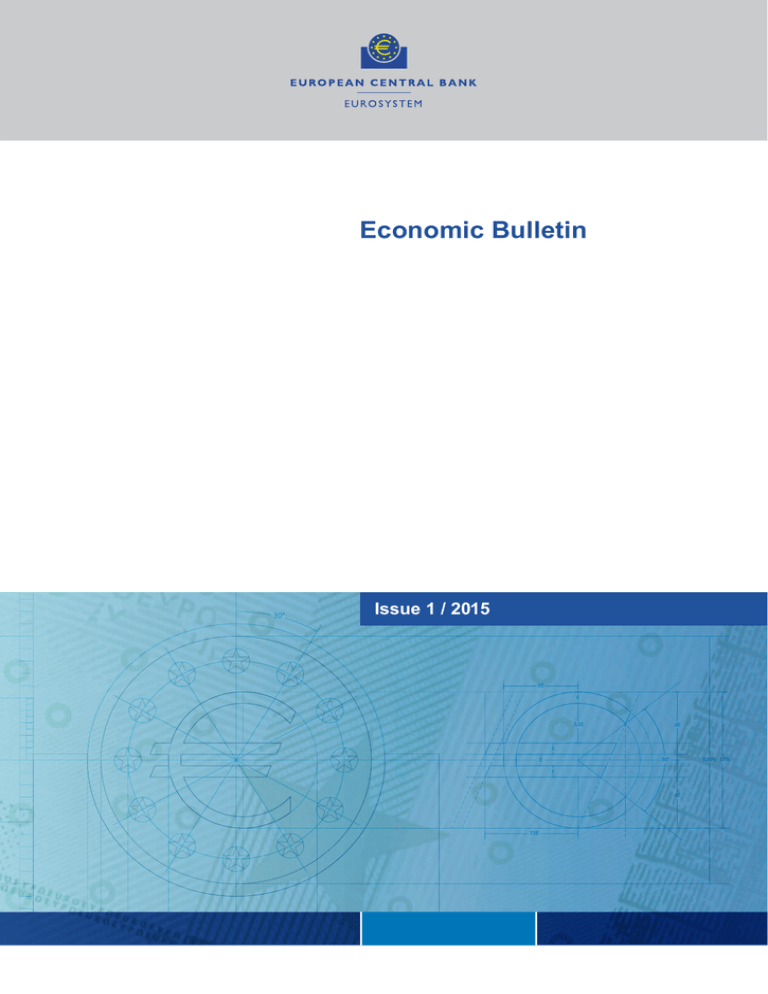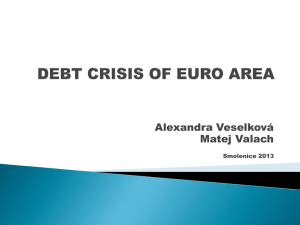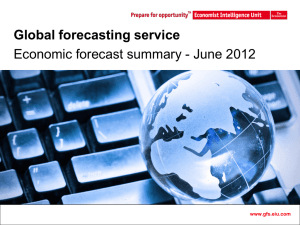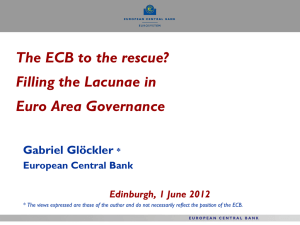
Economic Bulletin
30°
Issue 1 / 2015
6E
E
3,5E
6E
E
80°
E
100% 53%
E
6E
7,5E
© European Central Bank, 2015
Postal address
60640 Frankfurt am Main
Germany
Telephone
+49 69 1344 0
Website
www.ecb.europa.eu
This Bulletin was produced under the responsibility
of the Executive Board of the ECB. Translations are
prepared and published by the national central banks.
All rights reserved. Reproduction for educational and
non-commercial purposes is permitted provided that
the source is acknowledged.
The cut-off date for the statistics included in this issue
was 21 January 2015.
ISSN 2363-3417 (epub)
ISSN 2363-3417 (online)
EU catalogue number QB-BP-15-001-EN-E (epub)
EU catalogue number QB-BP-15-001-EN-N (online)
Contents
Update on Economic and monetary developments
Summary
5
1 External environment
6
2 Financial developments
8
3 Economic activity
9
4 Prices and costs
11
5 Money and credit
12
Boxes
Box 1 The Governing Council’s expanded asset purchase programme
15
Box 2 The outlook for China’s economy: risks, reforms and challenges
19
Box 3 Lithuania adopts the euro
21
Box 4 Recent developments in the labour force participation rate in the euro area
24
Box 5 The recent oil price decline and the euro area economic outlook
26
Box 6 Trends in profit margins of euro area non-financial corporations
29
Box 7 Flexibility within the Stability and Growth Pact
33
ARTICLE
Grocery prices in the euro area: findings from the analysis of a disaggregated price dataset
37
STATISTICS
S1
ECB
Economic Bulletin
Issue 1 / 2015
3
u p d a t e o n Ec o n o m i c a n d
monetary developments
Summary
The recent decline in oil prices is supporting the global economic recovery. Nevertheless,
the recovery remains gradual and economic developments vary across regions. Growth in the
United States remains robust, momentum is slowing in China, and activity in Japan has not regained
traction. Economic conditions in Russia have deteriorated further, but spillovers to other emerging
markets remain limited to date. Global trade is showing signs of strengthening. The decline in
energy prices has lowered inflation rates globally.
In euro area financial markets, short-term money market rates have declined further in an
environment of increased excess liquidity, temporarily reaching new historic lows. Long-term
interest rates also reached new historic lows, reflecting weak growth momentum and subdued
inflation dynamics, as well as market expectations of sovereign debt purchases by the Eurosystem.
At the same time euro area stock prices have increased. The exchange rate of the euro has
depreciated further, both in nominal effective terms and against the US dollar.
Overall, the latest economic indicators and survey results remain consistent with a moderate economic
expansion in the euro area in the short term, while the recent fall in oil prices should support growth in
the longer term. Meanwhile, although labour markets have shown some further signs of improvement,
unemployment remains high and unutilised capacity is expected to diminish only gradually.
Euro area HICP inflation declined significantly in December, to -0.2%. On the basis of current
information, the short-term inflation outlook remains weak and annual HICP inflation is likely to
stay very low or negative in the coming months. Supported by the ECB’s monetary policy measures,
the ongoing recovery and the assumption embedded in futures markets of a gradual increase in oil
prices in the period ahead, inflation rates are expected to increase gradually later in 2015 and in 2016.
The monetary analysis indicates that the annual growth of M3 recovered further in November.
The decline in loans to non-financial corporations has continued to moderate, while the growth
of loans to households has stabilised at a slightly positive level. These developments have been
facilitated by a broad-based and substantial reduction in lending rates recorded since summer 2014.
Despite the improvement in lending conditions, as reported in the January 2015 euro area bank
lending survey, credit standards still remain relatively tight. The ECB’s monetary policy measures
should support a further improvement in credit flows.
At its meeting on 22 January 2015, based on its regular economic and monetary analyses,
the Governing Council of the ECB conducted a thorough reassessment of the outlook for price
developments and of the monetary stimulus achieved so far. As a result, the Governing Council
decided:
• first, to launch an expanded asset purchase programme, encompassing the existing
purchase programmes for asset-backed securities and covered bonds as well as purchases of
euro-denominated investment-grade securities issued by euro area governments and agencies
and European institutions in the secondary market (for futher details, see Box 1);
• second, to change the pricing of the six remaining targeted longer-term refinancing operations
(TLTROs) by removing the 10 basis point spread over the rate on the Eurosystem’s main
refinancing operations that applied to the first two TLTROs;
• third, in line with its forward guidance, to keep the key ECB interest rates unchanged.
ECB
Economic Bulletin
Issue 1 / 2015
5
1External environment
The recent decline in oil prices is supporting the global economic recovery. In response to
a well-supplied oil market, Brent crude oil prices continued to decline sharply in December and
January (see Chart 1) and stood on 21 January 2015 about 31% below the levels of early December
(in US dollar terms). According to the futures curve, markets have priced in only a gradual increase
in oil prices for the coming years. As lower oil prices lead to a redistribution of income from net oil
producers to net oil consumers, this supports global demand, as net oil-consuming countries tend to
have a higher propensity to spend.
Despite the support from lower oil prices, the global economic recovery remains gradual,
and surveys point to some softening in the growth momentum in the fourth quarter of 2014.
The composite output Purchasing Managers’ Index (PMI) excluding the euro area fell slightly in
December to a level below both its long-term average and its third-quarter reading (see Chart 2).
Global trade continues to show signs of strengthening. The volume of world merchandise imports
excluding the euro area increased by 3.4% on a three-month-on-three-month basis in October,
moving further above its long-term average. However, the global PMI for new manufacturing
export orders moderated in the final quarter of 2014.
Falling energy prices are leading to a decline in global inflation. As a result, annual consumer
price inflation in the OECD area decreased further to 1.5% in November. The fall in inflation was
broad-based across major economies, except for Russia, which experienced a significant increase.
Annual OECD inflation excluding food and energy fell further to 1.7% in November. Given the
Chart 1 Brent crude oil prices and futures
Chart 2 Global composite output pmi
and Gdp
(USD or EUR per barrel)
(left-hand side: diffusion index quarterly averages; right-hand
side: percentages; quarterly data)
USD
futures (USD)
EUR
futures (EUR)
160
160
140
140
120
120
100
100
80
80
60
60
40
40
20
20
0
2008 2009 2010 2011 2012 2013 2014 2015 2016
Sources: Bloomberg and ECB staff.
Note: The futures curve is dated 21 January 2015.
6
quarter-on-quarter global GDP (right-hand scale)
composite output (left-hand scale)
ECB
Economic Bulletin
Issue 1 / 2015
0
65
1.8
60
1.2
55
0.6
50
0.0
45
-0.6
40
-1.2
35
2008
2009
2010
2011
2012
2013
2014
-1.8
Sources: Markit and ECB.
Note: The latest observation is for the fourth quarter of 2014 for
PMI and the third quarter of 2014 for GDP.
U P D A T E O N E c ono m i c
and m oneta r y
de v e l op m ent s
External environment
ongoing weakness in commodity prices, it is expected that significant downward pressures on
global inflation will continue.
US activity was stronger than expected, and indicators point to robust growth in the short term.
According to the third estimate, real GDP growth increased by 1.2% quarter on quarter in the third
quarter of 2014, which is the strongest growth rate in almost a decade. Recent data remained robust,
suggesting only a slight moderation in growth in the final quarter of the year. On balance, the
income windfall for consumers from lower oil prices is expected to more than offset the negative
impact from the further strengthening of the US dollar since December, thus providing a boost to the
overall outlook for the United States. At the same time falling oil prices are expected to lead to
lower CPI inflation in the short term, reinforced by downward pressures from the appreciation
of the US dollar. This was already reflected in a drop in annual CPI inflation to 0.8% in December
from the rate of 1.7% that had prevailed since August.
As Japan’s economy failed to re-gain sustained traction after the hike in VAT in April, the
government announced further fiscal stimulus measures. The second data release confirmed
the decline in Japanese real GDP by 0.5% quarter on quarter in the third quarter of 2014.
High-frequency indicators point to a return to positive, albeit weak, growth in the fourth quarter.
At the end of 2014 the government announced a stimulus package and a reduction in the effective
corporate tax rate in order to support growth. Meanwhile annual consumer price inflation continued
to ease to 2.4% in November, driven largely by lower energy prices.
In the United Kingdom, short-term indicators point to a slowdown in economic activity, while
inflation has fallen to very low levels. While activity will be supported by higher real disposable
income in view of falling energy prices, survey indicators point towards a near-term slowdown in the
pace of expansion. Annual CPI inflation eased further to 0.5% in December 2014 owing to lower
energy prices. At the same time annual CPI inflation excluding food and energy remained broadly
stable at around 1.3%.
Growth momentum in China has slowed, and inflation remains low. Quarterly GDP growth
slowed to 1.5% in the final quarter of 2014 on the back of weakness in the housing market and
heavy industries. In a longer term perspective, Chinese growth continues on its path of gradual
deceleration (see Box 2), although the recent drop in oil prices could provide some temporary
support. Annual consumer price inflation – at 1.5% in December – is hovering at close to two and
a half-year lows and is expected to decline further, reflecting both the slowdown in demand and the
current weakness in commodity prices.
While the economic situation deteriorated markedly in Russia, spillovers to other emerging
market economies remain limited thus far. With the fall in oil prices accelerating in December,
tensions in Russian financial and foreign exchange markets intensified, triggering forceful policy
action. Following a rise of 100 basis points at its regular meeting on 11 December 2014, the Central
Bank of Russia increased the policy rate by a further 650 basis points to 17% on 15 December 2014.
Repercussions on other emerging market economies have been comparatively limited. However,
there are some signs of deterioration in the financial market indicators of countries with closer
commercial links to Russia in the Commonwealth of Independent States and in Central and Eastern
Europe.
ECB
Economic Bulletin
Issue 1 / 2015
7
2 Financial developments 1
Short-term money market rates declined further in an environment of increased excess
liquidity, briefly registering a new historic low. This followed the settlement of the
December 2014 targeted longer-term refinancing operation (TLTRO), the second in the series,
which amounted to €129.8 billion, compared with the €82.6 billion settled in the first TLTRO
in September 2014. The net liquidity injection of the second TLTRO amounted to €95 billion,
contributing to a significant increase in excess liquidity. The EONIA declined from an average level
of around -2 basis points in the first week of the twelfth maintenance period to an average level of
around -5 basis points in the remaining four weeks (recording a new historic low of -8.5 basis
points on 24 December), amid higher excess liquidity. The EONIA stood at -6.8 basis points
on 21 January 2015 (see Chart 3).
Long-term interest rates in the euro area also reached new historic lows against the background
of a weak economic and inflation outlook. A synthetic measure of ten-year AAA-rated euro area
government bond yields showed that they declined from 0.84% on 4 December 2014 to a new
historic low of 0.48% on 16 January 2015 (see Chart 4). At the end of the review period they stood
at 0.54%. The decline in long-term yields reflected market expectations of a further weakening of
inflation dynamics in an environment of weak growth, as well as increasing market expectations
of sovereign debt purchases by the ECB. The yield on US Treasuries with a ten-year maturity
(see Chart 4) recorded a decline similar to that of euro area yields, suggesting that global factors
may have contributed to the decline in the synthetic measure of the ten-year AAA-rated euro area
government bond yields. The spreads between sovereign bonds in Germany and other euro area
Chart 3 eonia expectations based on the
overnight index swap yield curve
Chart 4 ten-year government bond yields
(percentages per annum)
(percentages per annum)
21 January 2015
post June Governing Council meeting
(5 June 2014 interest rate cut)
30 September 2014
euro area
United States
2.0
2.0
3.5
3.5
1.6
1.6
3.0
3.0
1.2
1.2
2.5
2.5
2.0
2.0
0.8
0.8
1.5
1.5
0.4
0.4
1.0
1.0
0.0
0.0
0.5
0.5
-0.4
2014
2015
2016
2017
2018
Sources: Reuters and ECB calculations.
2019
2020
-0.4
0.0
Jan.
8
Jan.
July
2013
Jan.
July
2014
0.0
Jan.
Sources: EuroMTS, ECB and Bloomberg.
Note: The euro area bond yield is based on the ECB’s data on
AAA-rated bonds, which currently include bonds from Austria,
Finland, Germany and the Netherlands.
1 The period under review is from 4 December 2014 to 21 January 2015.
ECB
Economic Bulletin
Issue 1 / 2015
July
2012
U P D A T E O N E c ono m i c
and m oneta r y
de v e l op m ent s
Economic activity
countries remained relatively stable, although in Greece political uncertainties led the spread to
increase by more than 200 basis points.
In the euro area, stock prices increased in the last part of the review period. The broad-based EURO
STOXX equity price index increased by 3.1% over the review period as a whole. The predominance
of dampening factors, such as weak growth momentum and the political uncertainties in Greece,
abated in the week of the monetary policy meeting of the Governing Council, amid market
expectations of sovereign debt purchases by the ECB. Stock market uncertainty in the euro area, as
measured by implied volatility, increased and ended the review period at levels that are at the higher
end of the range recorded over the past two years. The stock market in the United States weakened
over the review period – the Standard & Poor’s 500 index declined by 1.9% – and implied volatility
increased slightly.
The euro continued to depreciate amid expectations of further diverging monetary policies in the
euro area and abroad. Overall, the euro weakened by 3.4% in trade-weighted terms over the review
period. In the euro area, the subdued inflation outlook and declining benchmark bond yields, which
reflected, among other things, the global increase in risk aversion, weighed on the exchange rate.
The euro fell by 5.8% against the US dollar, which was supported by market uncertainty in an environment
of declining oil prices and heightened geopolitical tensions. The euro also continued to depreciate – albeit
at a slower pace – against the pound sterling, which reached a six-year high against the single currency.
Higher volatility and the decline in risk appetite supported the Japanese yen, leading the euro to decline
by almost 8% against the Japanese currency. Following the announcement of the Swiss National Bank
on 15 January 2015 that it would discontinue its minimum exchange rate target of 1.20 Swiss francs
per euro, the euro depreciated sharply against the Swiss franc, to trade at around parity thereafter.
The Danish krone continued to trade close to its central rate within ERM II, while Danmarks
Nationalbank reduced interest rates twice over the review period. In contrast, a weakening of the
currencies of central and eastern European countries mitigated the depreciation of the euro in
effective terms. On 1 January 2015 Lithuania adopted the euro and became the 19th member of the
euro area (see Box 3).
3ECONOMIC ACTIVITY
Following six quarters of positive output growth, most recent hard data remain consistent
with a further moderate economic expansion in the fourth quarter of 2014. In October
and November industrial production excluding construction stood, on average, 0.3% above its
third-quarter level, when production contracted by 0.4%. For the same period, construction
production stood 0.5% above the figure for the third quarter, when it also recorded a decline.
Recent developments in retail trade and car registrations are in line with continued positive private
consumption growth in the fourth quarter, while the production of capital goods points to a modest
expansion of euro area investment.
The outlook of a gradual recovery is also confirmed by more timely survey data. The euro area
composite output Purchasing Managers’ Index (PMI) declined from the third quarter to the fourth
quarter, mainly reflecting a weakening in sentiment for the services sector. However, the average
for the fourth quarter remains consistent with moderate positive growth, signalling a continuation of
the ongoing gradual recovery (see Chart 5). The economic sentiment indicator (ESI) also declined,
albeit marginally, over the same period. As with the PMI, the average for the fourth quarter of the
year is, however, still in line with an expansion of output.
ECB
Economic Bulletin
Issue 1 / 2015
9
Chart 5 euro area real Gdp, composite
purchasing managers’ index and economic
sentiment indicator
Chart 6 euro area employment, purchasing
managers’ index employment expectations
and unemployment
(quarter-on-quarter percentage growth; indices)
(quarter-on-quarter percentage growth; index; percentage of
labour force)
employment (left-hand scale)
PMI employment expectations (left-hand scale)
unemployment rate (right-hand scale)
real GDP (right-hand scale)
ESI (left-hand scale)
composite PMI (left-hand scale)
65
1.5
0.6
60
1.0
0.4
55
0.5
50
0.0
45
-0.5
40
-1.0
35
-1.5
-0.2
-0.8
-3.0
-1.0
2011
2012
2013
2014
Sources: Markit, DG-ECFIN, Eurostat and ECB.
Notes: The ESI is normalised with the mean and standard
deviation of the PMI over the period since January 2000. Latest
observations: third quarter of 2014 for GDP outcome, December
2014 for the economic sentiment indicator and Purchasing
Managers’ Index.
9
-0.6
-2.5
2010
10
-0.4
25
2009
11
0.0
-2.0
2008
12
0.2
30
20
13
8
2008
2009
2010
2011
2012
2013
2014
7
Sources: Eurostat and Markit.
Latest observations: third quarter of 2014 for employment,
November 2014 for unemployment and December 2014 for
the Purchasing Managers’ Index.
Labour markets, while still weak, have improved somewhat further. Employment rose by 0.2%
quarter on quarter in the third quarter of 2014, following an increase of 0.3% in the previous quarter
(see Chart 6). The unemployment rate for the euro area, which started to decline in mid-2013,
remained stable at 11.5% between August and November 2014 (see also Box 4). More timely
information obtained from survey results points to a modest strengthening of labour markets in the
last quarter of 2014.
Looking beyond the short term, the recent fall in oil prices should support growth,
particularly domestic demand, through gains in the real disposable income of households
and in firms’ profits (see Box 5). Domestic demand should also be supported by the Governing
Council’s monetary policy measures, the ongoing improvements in financial conditions and the
progress made in fiscal consolidation and structural reforms. Furthermore, demand for euro area
exports should benefit from the global recovery. However, the euro area recovery is likely to
continue to be dampened by high unemployment, sizeable unutilised capacity and the necessary
balance sheet adjustments in the public and private sectors. The results from the latest Survey
of Professional Forecasters show that private sector GDP growth forecasts were revised down
for 2015, by 0.1 percentage point to 1.1%, compared with the previous survey round, while those
for 2016 remained unchanged at 1.5%. At the same time, unemployment expectations remained
unchanged.
10
ECB
Economic Bulletin
Issue 1 / 2015
U P D A T E O N E c ono m i c
and m oneta r y
de v e l op m ent s
Prices and costs
4Prices and costs
The recent fall in oil prices has led to significant downward pressures on HICP inflation
(see Box 5). The annual rate of change of the euro area HICP was -0.2% in December 2014, the
first negative rate recorded since October 2009, and down from 0.3% recorded in November 2014
(see Chart 7). In contrast to headline inflation, HICP excluding food and energy continued on a
broadly stable path, remaining at 0.7% from October to December.
Price developments at the earlier stages of the production chain continue to signal a
subdued outlook for inflation. The annual rate of industrial producer price inflation excluding
construction and energy stabilised between October and November to stand at -0.2% in December.
Producer price inflation for non-food consumer goods declined slightly in November. Only the
annual rate of change of import prices for intermediate goods has seen the first positive recording
since November 2012, which can be partly explained by the recent depreciation of the euro effective
exchange rate. Pipeline pressures for HICP food have remained weak at each stage of the price
chain. In November, the annual rate of change in producer prices for consumer food fell slightly,
while euro area farm gate prices were also quite weak.
Labour cost growth continues to be moderate. The annual rate of change in compensation per
employee for the euro area fell slightly, making a year-on-year increase of 1.3% in the third quarter
of 2014, from 1.4% in the previous quarter (see Chart 8). Sectoral data indicate that the slower
annual growth in compensation per employee was mainly accounted for by lower contributions
from the industry and the construction sectors. The annual rate of change in unit labour costs for
the euro area was marginally higher at 1.1% in the third quarter of 2014, as the deceleration in
compensation per employee was more than offset by a slowdown in productivity growth.
Chart 7 Contribution of components to euro
area hiCp headline inflation
Chart 8 Compensation per employee,
productivity and unit labour costs in the
euro area
(annual percentage changes; percentage point contributions)
(annual percentage changes)
HICP
non-energy industrial goods
services
processed food
unprocessed food
energy
compensation per employee
productivity, inverted
unit labour costs
5
5
4
4
3
3
2
2
1
1
0
0
-1
-1
-2
-2
2008
2009
2010
2011
2012
2013
Sources: Eurostat and ECB calculations.
Note: The latest observation refers to December 2014.
2014
7
7
6
6
5
5
4
4
3
3
2
2
1
1
0
0
-1
-1
-2
-2
-3
2008
2009
2010
2011
2012
2013
2014
-3
Sources: Eurostat and ECB calculations.
Note: The latest observation is for the third quarter of 2014.
ECB
Economic Bulletin
Issue 1 / 2015
11
Similarly, profit margins remain weak. Profit growth (measured in terms of gross operating
surplus) remained unchanged at 1.0% in the third quarter of 2014 in line with the modest recovery
in economic growth. The weak dynamics reflected subdued contributions from real GDP growth
and growth in profits per unit of output (a measure for profit margins). From a sectoral perspective,
the subdued developments in profits are shared by the industrial and the market services sectors.
Box 6 discusses these recent profit developments in further detail.
Financial market indicators of medium and long-term inflation expectations have shown
signs of a weakening, while survey-based measures for longer-term expectations have
remained more stable. Long-term forward inflation-linked swap rates and the five-year forward
five-year ahead, bond-based break-even inflation rate declined substantially in December and
early January 2015, following the sharp decline in oil prices. These measures currently stand at
around 1.5-1.6%, possibly reflecting, to some extent, negative inflation risk premia. By contrast,
survey-based measures for longer-term inflation expectations remain broadly unchanged.
According to the ECB Survey of Professional Forecasters (SPF), for the first quarter of 2015, the
average inflation expectations for 2019 were around 1.8% (see survey at: www.ecb.europa.eu/stats/
prices/indic/forecast/shared/files/reports/spfreport201501.en.pdf). Shorter-term survey-based and
market-based inflation expectations, as measured by inflation swap rates, have continued to decline
and point to a very subdued outlook for inflation over the next two years.
On the basis of current information and prevailing futures prices for oil, annual HICP
inflation is expected to remain very low or negative in the months ahead. Supported by the
ECB’s monetary policy measures, the expected recovery in demand and the assumption of a gradual
increase in oil prices in the period ahead, inflation rates are expected to increase gradually later
in 2015 and in 2016. The results from the latest SPF imply average inflation expectations of 0.3%,
1.1% and 1.5% for 2015, 2016 and 2017 respectively. The downward revisions of 0.7 percentage
point for 2015 and 0.3 percentage point for 2016 mainly reflect lower oil prices.
5Money and Credit
Money dynamics remain on a path of recovery. The annual growth rate of M3 picked up to
3.1% in November, after 2.5% in October and the trough of 0.8% in April (see Chart 9). The rate
of increase over the past three months was 5% in annualised terms. The recovery of M3 growth was
broad-based across countries and sectors, and reflected high inflows into overnight deposits held
by both households and non-financial corporations (NFCs).
In an environment of very low interest rates, investors continue to search for yield. The low
remuneration of monetary assets encourages money holders to prefer overnight deposits to other
deposits or marketable instruments within M3, even though there are signs that the contraction of
marketable instruments is phasing out. While some investors have moved from less liquid deposits
included in M3 towards riskier assets outside M3, other investors have shifted away from longer-term
financial liabilities, thereby supporting M3 growth. The annual rate of change in longer-term MFI
financial liabilities (excluding capital and reserves) held by the money-holding sector declined
further in November. In addition, international investors again showed a keen interest in euro area
securities. In the 12 months to the end of November 2014, MFIs’ net external assets increased by
€315 billion. This figure largely reflects the net purchases by foreigners of securities issued by euro
area residents and current account surpluses.
12
ECB
Economic Bulletin
Issue 1 / 2015
U P D A T E O N E c ono m i c
and m oneta r y
de v e l op m ent s
Money and Credit
Chart 9 m3 and loans to the private sector
Chart 10 Credit standards and net demand
for loans to non-financial corporations
and households for house purchase
(annual rate of growth and annualised three-month growth rate)
(net percentages)
credit standards – loans to NFCs
credit standards – loans to households for house purchase
demand – loans to NFCs
demand – loans to households for house purchase
M3 (annual growth rate)
M3 (annualised three-month growth rate)
loans to the private sector (annual growth rate)
loans to the private sector
(annualised three-month growth rate)
16
16
14
14
12
12
10
10
8
8
6
6
4
4
2
2
0
0
-2
-2
-4
2005 2006 2007 2008 2009 2010 2011 2012 2013 2014
Source: ECB.
-4
75
75
50
50
25
25
0
0
-25
-25
-50
-50
-75
2008
2009
2010
2011
2012
2013
2014
-75
Source: ECB.
Loans to the private sector continue to recover gradually. The annual rate of change in
MFI loans to the private sector was -0.2% in November, after -0.5% in October (see Chart 9).
The gradual improvement in credit dynamics was visible across households and firms. The
annual rate of change in MFI loans to NFCs (adjusted for sales and securitisation) was -1.3%
in November, compared with -1.6% in October and the trough of -3.2% in February.
The annual growth of loans to households increased marginally to 0.7% in November, thus
remaining slightly above the average observed since early 2013. Despite these positive trends, the
consolidation of bank balance sheets and further deleveraging needs in some economic sectors and
banking jurisdictions still curb credit dynamics.
The reductions in bank lending rates have been sizeable since summer 2014. The overall nominal
cost of external financing for euro area NFCs declined in the fourth quarter of 2014, after having
stabilised in the autumn of 2014. The cost of market-based debt has continued to fall in January
2015, while the cost of equity has stabilised. The declines were due to the ECB’s accommodative
monetary policy stance, the decrease in banks’ composite funding costs, which have stabilised close
to historically low levels, and increased competition among banks for loans. Rates on loans to NFCs
declined further in November, in particular in the case of long-term loans (the cost-of-borrowing
indicator for euro area NFCs fell to 2.5% in November, compared with 2.8% in June). Rates on
loans to households for house purchase also fell in November, (the cost-of-borrowing indicator
for households for house purchase decreased to 2.6%). At the same time, the cost of deposit
funding for euro area banks remained broadly stable, while yields on bank bonds declined slightly.
MFI issuance of debt securities remained negative, and the ongoing contraction of balance
sheets and the strengthening of the banks’ capital base is reducing the need for banks to seek
funding via debt securities issuance.
ECB
Economic Bulletin
Issue 1 / 2015
13
The January 2015 euro area bank lending survey points to improvements in lending
conditions; however, credit standards remain tight from a historical perspective
(see survey at: www.ecb.europa.eu/stats/pdf/blssurvey_201501.pdf). Banks continued to ease
credit standards for loans to both NFCs and households (in net terms) in the fourth quarter of
2014 (see Chart 10). These positive developments were driven by improved cost of funds and
balance sheet conditions, as well as by stronger competitive pressures. In addition, the impact
of the targeted longer-term refinancing operations (TLTROs) on the loan supply is expected to
largely translate into a narrowing of lending margins. The survey points to a pick-up in demand
for loans to NFCs and consumer credit, and a continued increase in the demand for housing loans
(see Chart 10). Firms’ loan demand was largely driven by financing needs for fixed investment.
However, the overall growth in external financing of non-financial corporations in the euro
area, viewed on an annual basis, remains relatively weak. According to the most recent euro
area accounts, debt securities issuance by euro area NFCs moderated in the third quarter of 2014
but remained sufficient, together with robust equity issuance, to more than offset the declining net
redemptions of bank loans. Securities issuance data for October and November suggest that the
flows remain positive and support a gradual increase in the external financing of euro area NFCs.
14
ECB
Economic Bulletin
Issue 1 / 2015
BOXES
Box 1
The Governing Council’s expanded asset purchase programme
At its meeting on 22 January 2015 the Governing Council of the ECB decided to launch an
expanded asset purchase programme (APP), encompassing the existing purchase programmes






